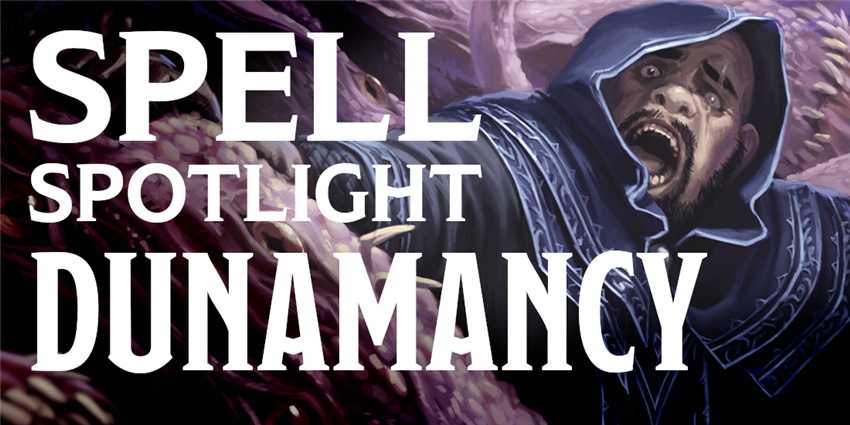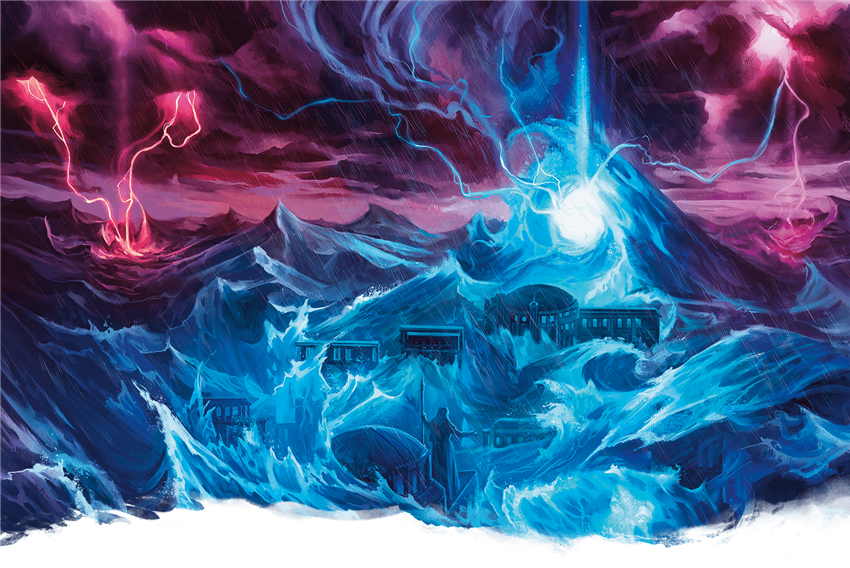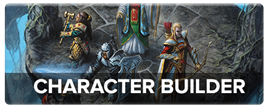Dunamancy is a type of magic unique to the world of Exandria, the setting of Critical Role. At its core, dunamancy is magic that commands the power of potentiality and actuality. These concepts are to metaphysics and potential energy and kinetic energy are to real-life physics; dunamancy grants its practitioners power over things that could be. Dunamancers draw power from alternate timelines and unseen realities, subtly affect the flow of time, and even tighten or loosen the grip of gravity. This Spell Spotlight takes a close look at some of the most interesting dunamancy spells presented in Explorer’s Guide to Wildemount.

Who Can Learn Dunamancy?
Chapter 4 of Explorer’s Guide to Wildemount contains 15 dunamancy spells, as well as two Arcane Traditions that have emerged among wizards who study the art of dunamancy: graviturgy and chronurgy. Graviturgists specialize in the primal power of gravity, and chronurgists manipulate the pace of reality itself. A third subclass, the Echo Knight, wields the power of dunamancy without casting spells by creating echoes of itself from alternate realities.
Some of the 15 spells in Explorer’s Guide to Wildemount are available only to graviturgists, while others are only available to chronurgists. Even though these spells are restricted to the wizard class (and then further restricted to certain subclasses), the book provides guidance on how the DM can allow other spellcasters can learn them. Take a look at the “Dunamancy for Non-Dunamancers” sidebar in chapter 4 of Explorer’s Guide to Wildemount.
Spell Spotlights
Though we can’t cover all 15 spells presented in chapter 4 of this book, we will take a look at the most interesting—and the ones with the greatest potential for joy, sorrow, or confusion at the table. We’ll start with a humble dunamancy cantrip and work our way up to one of this book's two powerhouse 9th-level spells.
Sapping Sting
 Sapping sting is a cantrip that, in terms of raw damage, seems a bit dodgy at first glance. However, dig a bit deeper and it reveals its true potential. Immediately comparable to vicious mockery, a cantrip which also deals 1d4 damage plus a debuff on a failed save, the real power of sapping sting is the ability to knock a creature prone as you sap strength from its limbs. With no limit on the size or power of the creature you can affect, even a mighty ancient red dragon could be forced to kneel if it fails this save. Being able to knock creatures prone is especially potent against dragons and other fliers because a flying creature that falls prone plummets to the ground. That could be a lot of falling damage if you sap strength from a flying dragon’s wings!
Sapping sting is a cantrip that, in terms of raw damage, seems a bit dodgy at first glance. However, dig a bit deeper and it reveals its true potential. Immediately comparable to vicious mockery, a cantrip which also deals 1d4 damage plus a debuff on a failed save, the real power of sapping sting is the ability to knock a creature prone as you sap strength from its limbs. With no limit on the size or power of the creature you can affect, even a mighty ancient red dragon could be forced to kneel if it fails this save. Being able to knock creatures prone is especially potent against dragons and other fliers because a flying creature that falls prone plummets to the ground. That could be a lot of falling damage if you sap strength from a flying dragon’s wings!
Of course, an ancient red dragon is “pretty good” at Constitution saves (read: it has a +16 bonus) so the odds of it failing that save aren’t in your favor. Still, use this spell cleverly and you might have a dragon burning one of its uses of Legendary Resistance on a cantrip. That feels good.
Magnify Gravity
Magnify gravity is a 1st-level area-of-effect spell that increases gravity in a small area, dealing moderate damage and halving the speed of creatures within that area. These effects are good on their own, but there’s another side effect that could be exploited through clever teamwork. Unattended items within that area require a successful Strength check to pick up. This makes this spell a great low-level way to prevent villains from picking up plot-relevant artifacts, enemy warriors from picking up disarmed weapons, and so on. Team up with your party’s Battle Master fighter to keep enemies empty-handed!
Pulse Wave
Pulse wave is a 3rd-level area-of-effect spell that damages enemies in a 30-foot-cone and either pushes them away from you or pulls them towards you. It’s one of the few evocation spells in the game with a cone-shaped area, and its ability to push or pull creatures in such a sizeable area is quite potent when paired with spells like moonbeam, Evard’s black tentacles, spirit guardians, or a powerful new dunamancy spell called dark star. All of these spells deal damage when a creature enters its area for the first time on a turn, so a coordinated party ping-pong enemies back and forth through dangerous areas using spells like pulse wave or eldritch blast (with the repelling blast invocation), or even the battering shield, a new magic item in chapter 6 of Explorer’s Guide to Wildemount.
This spell doesn’t discriminate between friend and foe. If you’re a sorcerer or an Evocation wizard and manage to gain access to this spell, Sculpt Spell or the Careful Spell metamagic will make using it a lot easier.
Notably, both the damage dealt AND the distance pushed or pulled scales with this spell when cast at higher levels. For instance, a 6th-level pulse wave can blast creatures a whopping 30 feet away!
Temporal Shunt
 Temporal shunt is a 5th-level spell that allows you to momentarily shunt an attacking enemy into another point in time. This spell doesn’t just work on attackers, but on creatures casting spells, too! The attack automatically misses or the spell is spent with no effect, and the creature is banished to another time until the start of its next turn. This spell can be used as a high-level substitute for counterspell (and even boasts an impressive 120-foot range, compared to counterspell’s 60-foot range), and comes with the additional utility of being able to disrupt physical attackers and do light crowd control with its banishment-like effect.
Temporal shunt is a 5th-level spell that allows you to momentarily shunt an attacking enemy into another point in time. This spell doesn’t just work on attackers, but on creatures casting spells, too! The attack automatically misses or the spell is spent with no effect, and the creature is banished to another time until the start of its next turn. This spell can be used as a high-level substitute for counterspell (and even boasts an impressive 120-foot range, compared to counterspell’s 60-foot range), and comes with the additional utility of being able to disrupt physical attackers and do light crowd control with its banishment-like effect.
This spell’s crowd control abilities scale at higher levels, too. Though the spell still triggers when an enemy attacks or casts a spell, you can target an additional creature for each slot level above 5th—as long as all of the targets are within 30 feet of one another.
Ultimately, temporal shunt isn’t quite as powerful as either counterspell or banishment on their own, but put together it becomes an incredibly efficient and stylish spell.
Tether Essence
Tether essence is a 7th-level spell that saw a LOT of discussion on social media right after the release of Explorer’s Guide to Wildemount. It links two creatures together with a strand of fate for one hour, such that when one creature receives damage or is healed, the other creature is also damaged or healed for the same amount.
This spell is quite versatile, with three primary combinations that you can use in creative ways. These setups are ally to ally, enemy to enemy, and ally to enemy. Ally to ally is a simple and straightforward way of doubling your party’s healing output; it’s best used outside of combat because it could actually make your allies more vulnerable to attack while in combat. Enemy to enemy is a similarly straightforward method of doubling your party’s damage output. This can be used to turn your enemies’ greatest strengths against them, such as by tethering a high-AC low-hp speedster to a low-AC high-hp juggernaut. This route is risky, however—if either foe should succeed on their Constitution saving throw (typically a strong save for big, brutish foes), the spell has no effect. That’s a huge gamble to bet a 7th-level spell slot on.
The most interesting use of tether essence, however, has to be the ability to tether an enemy to an ally. By tethering the life force of your most powerful front-line fighter to the life of the enemy commander, every hit your tank takes also deals damage to the boss. This works especially well for subclasses like the Path of the Ancestral Warrior barbarian or the Oath of Redemption paladin, both in Xanathar’s Guide to Everything, which have features that encourage enemies to attack them instead of their allies. Alternatively, tethering the life force of your frail wizard to that of a powerful enemy is a strong incentive for the enemy to avoid attacking an easy target.
Reality Break
This is where dunamancy spells start getting frightful. Reality break is an 8th-level spell that causes several different timelines and potential realities to converge at once upon a single creature. This spell is a powerful way to lock down a single creature while also inflicting heavy damage. Its potency is balanced somewhat by its random nature; you can’t choose to stun the creature every turn, but you could blind it or hurl it through space, which are powerful effects in their own right.
This spell’s effects are straightforward, but its concept is very much in the realm of weird fantasy, bordering on sci-fi with its mentions of wormholes and the dark void. If you’re a player or a DM that wants to engage in that weird flavor, here are some lines you can use to describe each of this spell’s effects:
Vision of the Far Realm. “Your vision swims and splits, as if you were seeing through ten thousand eyes at once. You begin to see something beyond—a sickening kaleidoscope of roiling shapes and colors. Caving under the assault, your mind goes numb.”
Rending Rift. “You feel your body split in two, like a paper doll torn straight down the middle. Your two halves flutter through time for what feels like a thousand years, and then you are suddenly whole again, and no time has passed at all.”
Wormhole. “A vortex of countless inky colors opens beneath you and swallows you whole. You travel at impossible speed, seeing this battle from a thousand different realities, then suddenly pop back into being and are hurled into the ground.”
Chill of the Dark Void. “The world freezes, and sound halts. Then still image before your eyes is stripped of its color, and you see the world as if it were a sketch on an artist’s page. Then the lines between forms is torn away, then light, then heat itself. Everything is stripped away until all that is left is darkness.”

Ravenous Void
Nothing escapes true darkness. Ravenous void is a 9th-level spell that essentially creates a black hole. It’s an incredible show of power, and any evil evoker will be hard-pressed to choose between this spell and meteor swarm as their most powerful spell. It’s hard to beat meteor swarm in the shock and awe department, but creating a black hole and sucks everything within 100 feet of it into its annihilating maw.
Not only do creatures have to escape the void by making a Strength check, they also have to be able to travel 100 feet away in order to prevent themselves from being sucked right back in at the start of their next turn. Dimension door could do it, but what about the rest of your party? A monk with a through-the-roof movement speed could even escape this spell's event horizon without casting a spell, but anyone without supersonic speed or the ability to teleport over 100 feet away is in serious trouble. This spell is best used in a confined dungeon environment, perhaps with an immensely tall ceiling. Since this spell has a staggering 1,000-foot range, a spider climbing wizard lurking on top of a vaulted ceiling or flying high above a canyon could cast this spell, feather fall to safety (as their concentration switches to ravenous void) and drift away, cackling as a black hole annihilates their foes. This spell becomes even more frightful when paired with clever use of effects that pull and push foes like pulse wave and gravity fissure (another dunamancy spell we didn’t have time to analyze in this spotlight), ravenous void is a party-annihilating spell perfect for omnicidal liches and other evil archmagi. Use with extreme caution.
Dunamancy in Your Campaign
There are still eight more dunamancy spells in Explorer’s Guide to Wildemount that we didn’t have room to explore in this Spell Spotlight. In some cases, this is because the spell is useful but quite straightforward, like the initiative-boosting gift of alacrity. In others, it’s because it has similarities to another spell we already covered on this list, like dark star compared to ravenous void. These spells do have notable differences, but a line has to be drawn somewhere.
The bottom line when it comes to dunamancy has to be: how will you use it? The art of dunamancy is a closely guarded secret in the world of Critical Role, and you could keep it as a rare and forgotten art in your campaign. Or, you could simply add these spells to the pool of spells available to all wizards, and ignore any distinction between dunamancy and the commonly known spells in the Player’s Handbook.
My recommendation is to keep dunamancy a rare power in your campaign setting unless you have a good reason not to. Since they’re not a part of the spells available to players in the Player’s Handbook and Xanathar’s Guide to Everything, most players won’t know about these spells at all! This makes them perfect rewards for spellcasters in the place of magic items, or as surprising powers for your monsters to wield against the players. Or both; perhaps defeating a monster infused with the power of dunamancy imparts those who defeat it with the ability to use those powers.

Getting Dunamancy a la Carte
Explorer’s Guide to Wildemount is an excellent campaign setting (though I’m biased; I helped write it). Nevertheless, if you’re only interested a few mechanic goodies within the book, you can get them piecemeal in the D&D Beyond Marketplace. This lets you buy individual dunamancy spells as you need them, or the individual subclasses of Graviturgist, Chronurgist, and Echo Knight, or even individual magic items if you just want to add just one to your treasure hoard.
As always, buying an item a la carte on D&D Beyond subtracts the price you paid from the whole book. So, if you spend $20 on individual spells, items, and subclasses, the rest of the book will only cost $10.
Which of these new spells are you most excited by? How will you use dunamancy in your home D&D campaign? Let us know in the comments!
Create A Brand-New Adventurer Acquire New Powers and Adventures Browse All Your D&D Content
 James Haeck is the lead writer for D&D Beyond, the co-author of Waterdeep: Dragon Heist, Baldur's Gate: Descent into Avernus, and the Critical Role Explorer's Guide to Wildemount, a member of the Guild Adepts, and a freelance writer for Wizards of the Coast, the D&D Adventurers League, and other RPG companies. He lives in Seattle, Washington with his fiancée Hannah and their animal companions Mei and Marzipan. You can find him wasting time on Twitter at @jamesjhaeck.
James Haeck is the lead writer for D&D Beyond, the co-author of Waterdeep: Dragon Heist, Baldur's Gate: Descent into Avernus, and the Critical Role Explorer's Guide to Wildemount, a member of the Guild Adepts, and a freelance writer for Wizards of the Coast, the D&D Adventurers League, and other RPG companies. He lives in Seattle, Washington with his fiancée Hannah and their animal companions Mei and Marzipan. You can find him wasting time on Twitter at @jamesjhaeck.











-
View User Profile
-
Send Message
Posted Apr 1, 2020For Ravenous Void a creature could use Dimension Door to simply escape it because the restrained condition doesn't prevent them from casting. Also the way it is worded is confusing because of its use of "a creature that enters the area for the first time on a turn or starts its turn there takes X damage and is restrained". Typically when a spell says a creature enters a spell area for the first time on a turn it means the creature willingly moves into the area and is not forced into it. By this wording the spell allows a creature to, at the start of their turn make a Strength save or be pulled into the center, but not restrained. So if they have enough movement or a magical means of teleporting out of the area they can do so instantly with no negative effect.
I suppose the RAI way to interpret it is the creature fails its Strength save is then pulled in takes the damage and is restrained. Then they take the damage again at the start of each of their turns. I love this spell, but since the graviturgist subclass has 1 less ability than similar subclasses and 2 of its abilities require concentration to use the entire gravity based spellcaster seems very hard pressed to not use concentration spells. The spell doesn't affect all creatures in its area until the start of their turns, so it is entirely possible for an enemy to succeed on the save and then hit you breaking concentration and wasting your 9th level. The best way to use the spell is going to be preemptive at a great distance.
-
View User Profile
-
Send Message
Posted Apr 1, 2020Just clarifying here, the text under the title "Dunanancy Spells" says "...These spells are available to the wizard subclasses previously mentioned in this chapter..." The "Dunanancy for Non-Dunamancers" sidebar says the same thing. I took this to mean that either the graviturgist and the chronomancer has access to *all* the Dunanancy spells, but your post suggests that they can only take the spells that belong in their specific category + the unsorted spells. Which is correct?
-
View User Profile
-
Send Message
Posted Apr 1, 2020The rules are ambiguous on this case, which is fine. It's up to the DM to make a ruling, since there isn't any rules text explicitly stating that "graviturgy spells" and "chronurgy spells" are only available to their respective subclasses.
-
View User Profile
-
Send Message
Posted Apr 1, 2020Some of these could be added to the shadow sorcerer origin spell list to make the SS more compelling: For example Reality Break (worm hole) or Ravenous Void fit nicely into the SS theme.
-
View User Profile
-
Send Message
Posted Apr 1, 2020Now we just need you guys to open the spells up to all classes and let DMs sort who can and can't have them at their individual tables instead of making us do extra work to make spells that already exist. ;)
-
View User Profile
-
Send Message
Posted Apr 1, 2020DnD beyond's character builder seems to take the stance that of 'chronurgy spells' are for chronurgy only and 'graviturgy spells' for graviturgy only.
-
View User Profile
-
Send Message
Posted Apr 2, 2020I feel like temporal shunt should be fourth level.
-
View User Profile
-
Send Message
Posted Apr 2, 2020Can we agree that is dumb the wizard has enough spells... power to the sorcerers!!!
-
View User Profile
-
Send Message
Posted Apr 2, 2020Is there no way to search for all articles on spells ?
-
View User Profile
-
Send Message
Posted Apr 2, 2020Click on the Spell Spotlight tag at the very bottom of this article. That will show you all articles in the Spell Spotlight series. =)
-
View User Profile
-
Send Message
Posted Apr 2, 2020Quick question: I was wondering about the Echo Knight’s ability to bring forth an alternate timeline version of themselves. Seeing as how EGtW is based off of the world of Critical Role, I assumed the wizard subclass would be able to do this with the Resonant Echo spell Liam O’Brien’s character learns. I haven’t been able to find the spell individually on the market place though. Is it an Echo Knight only ability in the official book?
-
View User Profile
-
Send Message
Posted Apr 2, 2020Yes, it is. I've created a Resonant Echo homebrew spell, if you want to see it. Resonant Echo
-
View User Profile
-
Send Message
Posted Apr 2, 2020Thanks !
couldn’t find it in search function
-
View User Profile
-
Send Message
Posted Apr 3, 2020Yeah, the search bar only searches your Compendium content. If you want to browse articles, you'll need to search through tags, or use the Articles page under the Media dropdown menu.
-
View User Profile
-
Send Message
Posted Apr 3, 2020If a DM wants to give a Dunamancy spell to one of their players is there any way to add it to their spell selection list within the UI? Every time I've tried to search the spells to test I can only find them if the character is one of the two subclasses. If I want to give this to one of my players playing a knowledge cleric how do I do it in DNDBeyond? Printing a card and hoping he remembers it (or doesn't fudge his daily spell selection) isn't ideal.
-
View User Profile
-
Send Message
Posted Apr 3, 2020A magic item or re-making the spell as homebrew is your best bet
-
View User Profile
-
Send Message
Posted Apr 3, 2020At first I thought this was an april fools joke, then I realized that Dan Telfer wasn't the author
-
View User Profile
-
Send Message
Posted Apr 4, 2020This is the way I did it. Go to Browse & Create in Creations then go to Create Homebrew Spells select whichever spell you wish to create there. Then you need to click Create you should then see a copy of the spell. Go to AVAILABLE FOR CLASS(ES) remove the two wizard subclasses so they are not getting another copy of that spell if you make one later and pick which classes or subclasses you wish to gain access to the spell.
-
View User Profile
-
Send Message
Posted Apr 4, 2020[Comment Deleted]
-
View User Profile
-
Send Message
Posted Apr 4, 2020Thanks man, that’ll work great.